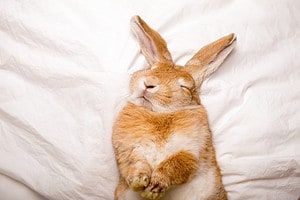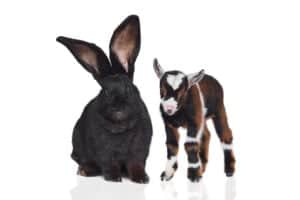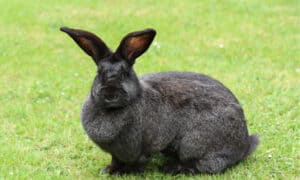With its gentle demeanor and impressive size, the Flemish Giant rabbit is the world’s largest breed of domesticated rabbit. With its origins shrouded in mystery and charm, the Flemish Giant has become a popular pet choice for those seeking a gentle giant as a companion. Aside from their large size, how long do Flemish Giant rabbits live? Let’s delve into the details.
How Long do Flemish Giant Rabbits Live?

The Flemish Giant rabbit is renowned for its colossal size and variety of coat colors. It can reach lengths of around 2.5 to 4 feet (76 to 122 centimeters) and weigh in at a hefty 14 to 16 pounds (6.4 to 7.3 kilograms) on average. Though, they can achieve weights upwards of 22 pounds (10 kilograms). Their size alone is a testament to their impressive genetic lineage, which may have involved the interbreeding of larger European rabbits during their development.
One of the most common questions asked by prospective Flemish Giant rabbit owners is about their lifespan. How long do Flemish Giant rabbits live? These majestic creatures can live for a significant number of years when cared for properly. On average, the Flemish Giant rabbit’s life expectancy ranges from 8 to 10 years. However, with dedicated care and attention, some individuals have been reported to reach the remarkable age of 12 years or more.
Various factors, including genetics, diet, environment, and medical care, can influence the longevity of the Flemish Giant rabbit’s life. Let’s explore some of the key factors that impact their lifespan.
Genetics
The foundation of any living being’s life expectancy lies in their genetic makeup. Responsible breeders strive to select breeding pairs with robust genetics, which can positively impact the overall health and longevity of the offspring. By selecting rabbits with a history of long and healthy life spans, breeders aim to pass down favorable traits to subsequent generations.
There are some health and genetic issues Flemish Giants are predisposed to that affect how long they live. Among the potential health concerns is GI stasis, a condition wherein a rabbit’s digestive system experiences a slowdown or halts entirely. Stress, dehydration, or an underlying medical issue can trigger this condition. When left untreated, GI stasis could lead to intestinal blockage and, ultimately, fatality. However, early detection allows for effective treatment. Signs encompass a decrease in fecal pellets, diminished appetite, and noticeable lethargy.
Another concern is Malocclusion, a term used to describe misaligned teeth, which poses a significant challenge. Rabbit teeth possess an ongoing growth cycle, and misalignment disrupts the natural wear-down process, leading to overgrowth and often sharp edges. Regular dental checkups with a veterinarian become even more essential than usual in ensuring a rabbit’s oral health is in healthy shape. Additionally, the ailment known as sore hocks involves inflammation and rawness on the soles of a rabbit’s feet. Contributing factors encompass obesity, unsuitable cage floorings such as wire surfaces, fur loss on the feet, and underlying skeletal issues like arthritis. Finally, a prevalent concern in rabbits, uterine cancer stands as the most frequently diagnosed cancer type. Remarkably, around 60% of female rabbits aged three years and older experience this ailment. While treatment options exist, they often involve the surgical removal of the rabbit’s uterus.
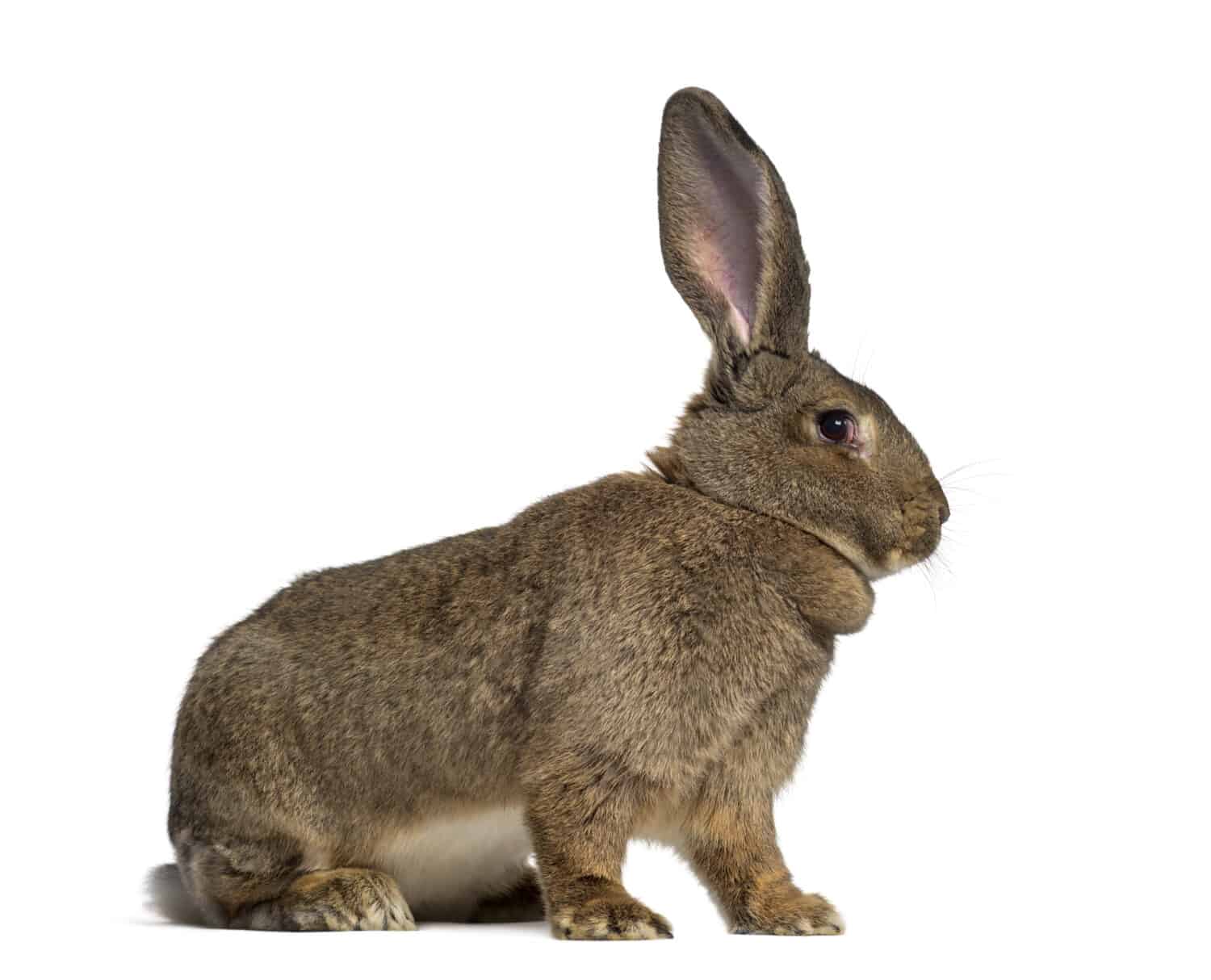
Flemish Giant rabbits can reach lengths of 2.5 to 4 feet (76 to 122 centimeters) and weigh 14 to 22 pounds (6.4 to 10 kilograms).
©Eric Isselee/Shutterstock.com
Diet
Proper nutrition is crucial in ensuring the well-being and longevity of the Flemish Giant rabbit. They thrive on a diet that is high in protein and fiber. Hay makes up around 70% of their diet. Moreover, a balanced diet rich in high-quality timothy hay, fresh vegetables, specially formulated rabbit pellets, supplemental salt and mineral blocks, and occasional treats such as fruit provide essential nutrients for growth, maintenance, and overall health. A well-fed rabbit is more likely to thrive and live a longer, healthier life.
Environment
The living conditions in which a Flemish Giant rabbit resides play a significant role in its well-being. A spacious, clean extra-large enclosure that allows ample room for exercise and movement is essential. Proper ventilation, protection from extreme temperatures, and a safe, stress-free environment are all important. Furthermore, like all rabbits, Flemish Giant rabbits need regular time outside their enclosure to explore, stretch their bodies, and move around freely. They also need plenty of love, affection, and mental stimulation. All of these factors contribute to a happier and healthier rabbit.
Medical Care
Routine veterinary checkups and preventive care are vital components of ensuring a long, healthy life for Flemish Giant rabbits. Regular health assessments help identify and address any potential health issues early on, thus increasing the chances of successful treatment. Vaccinations, parasite control, and dental care are all critical aspects of a comprehensive healthcare regimen for these gentle giants.
Spaying and Neutering
The question of whether spaying or neutering influences the life expectancy of Flemish Giant rabbits has been the subject of debate among rabbit owners and veterinarians. Spaying is the surgical removal of a female rabbit’s reproductive organs, while neutering involves the castration of male rabbits.
Some studies suggest that spaying or neutering rabbits can lead to a longer life, mainly by reducing the risk of certain reproductive-related illnesses and behavioral issues. For female rabbits, spaying can prevent uterine cancer, pyometra (infection of the uterus), and ovarian tumors. For male rabbits, neutering can help reduce aggression and though rare in and of itself, decrease the risk of testicular cancer.
However, it is essential to note that spaying or neutering should be considered individually and performed by a skilled and experienced veterinarian specializing in rabbit care. The procedure itself carries risks, and post-operative care is crucial to ensure a smooth recovery.
Overall, these majestic giants can live long lives with proper care, a balanced diet, a nurturing environment, and regular veterinary checkups. Additionally, spaying or neutering may contribute positively to their life expectancy by preventing certain reproductive-related illnesses and behavioral problems. So, whether you’re a seasoned rabbit owner or are considering bringing one of these enchanting creatures into your life for the first time, providing them with the love and care they deserve will undoubtedly reward you with many years of joy and companionship.

Flemish Giant rabbits are the largest domesticated breed of rabbits in the world. They originated in Belgium around the 16th century, but the first standards for the breed weren’t recognized until the late 1800s.
©Veroja/Shutterstock.com
Origin of the Flemish Giant Rabbit
The origins of the Flemish Giant rabbit are rich in curiosity, diversity, and intrigue. These gentle giants are believed to have emerged from Flanders, a historical region that spans the northern region of Belgium. The breed’s exact timeline is shrouded in the mists of time, but it is thought to have been bred as early as the 16th century. However, the first standards for the breed weren’t written until the 1890s. The breed descends from several meat and fur rabbit breeds. People initially bred them for a variety of purposes, primarily for their large size that supplied meat and fur.
The Flemish Giant started gaining popularity in livestock shows in the early 1900s. Soon after, the breed became popular for more than its meat and fur supplies but also for its varied purposes as a lovable pet, show rabbit, and breeding rabbit. Due to their uniquely docile personality and cleanliness, they quickly became popular pets across Europe and North America and still are to this day.
Selective Breeding and Purpose
The Flemish Giant rabbit’s grandeur did not happen by chance; it resulted from careful and deliberate selective breeding. The breeders of old, with a keen eye for innovation, sought to create a robust and sizeable rabbit for practical purposes. As mentioned, people initially developed the breed for meat and fur production, and its size became a valuable asset for these endeavors.
People selectively bred these rabbits for their impressive growth rate, large frames, and dense fur coats. In a time when agriculture played a pivotal role in society, the Flemish Giant rabbit quickly found favor among farmers and furriers alike. Its ample size allowed for substantial meat yields and its luxurious fur was sought after for crafting warm garments. The breed’s capacity to thrive in various environments and its gentle demeanor only added to its appeal over time.
Selective Breeding and Life Expectancy
The historical purpose for which people bred the Flemish Giant rabbit holds a unique connection to its life expectancy. While the average lifespan of these majestic creatures ranges from 8 to 10 years, with proper care and attention, some individuals have surpassed the decade mark. The foundation of the breed’s longevity traces back to its heritage and the careful breeding practices employed by those who recognized its potential.
Selective breeding aims at developing robust, adaptable, and resilient rabbits with optimal growth rates and healthy characteristics. This meticulous process inadvertently contributed to the breed’s overall health and lifespan. By prioritizing traits such as size, coat density, temperament, and crossbreeding, breeders indirectly favored rabbits with the potential for extended lives.
Furthermore, rabbits that exhibited good health, hardiness, and efficient growth were selected for breeding, passing down their advantageous genetic traits to successive generations. These traits, in turn, supported the rabbits’ ability to resist diseases and adapt to changing environments, contributing to their prolonged lives.
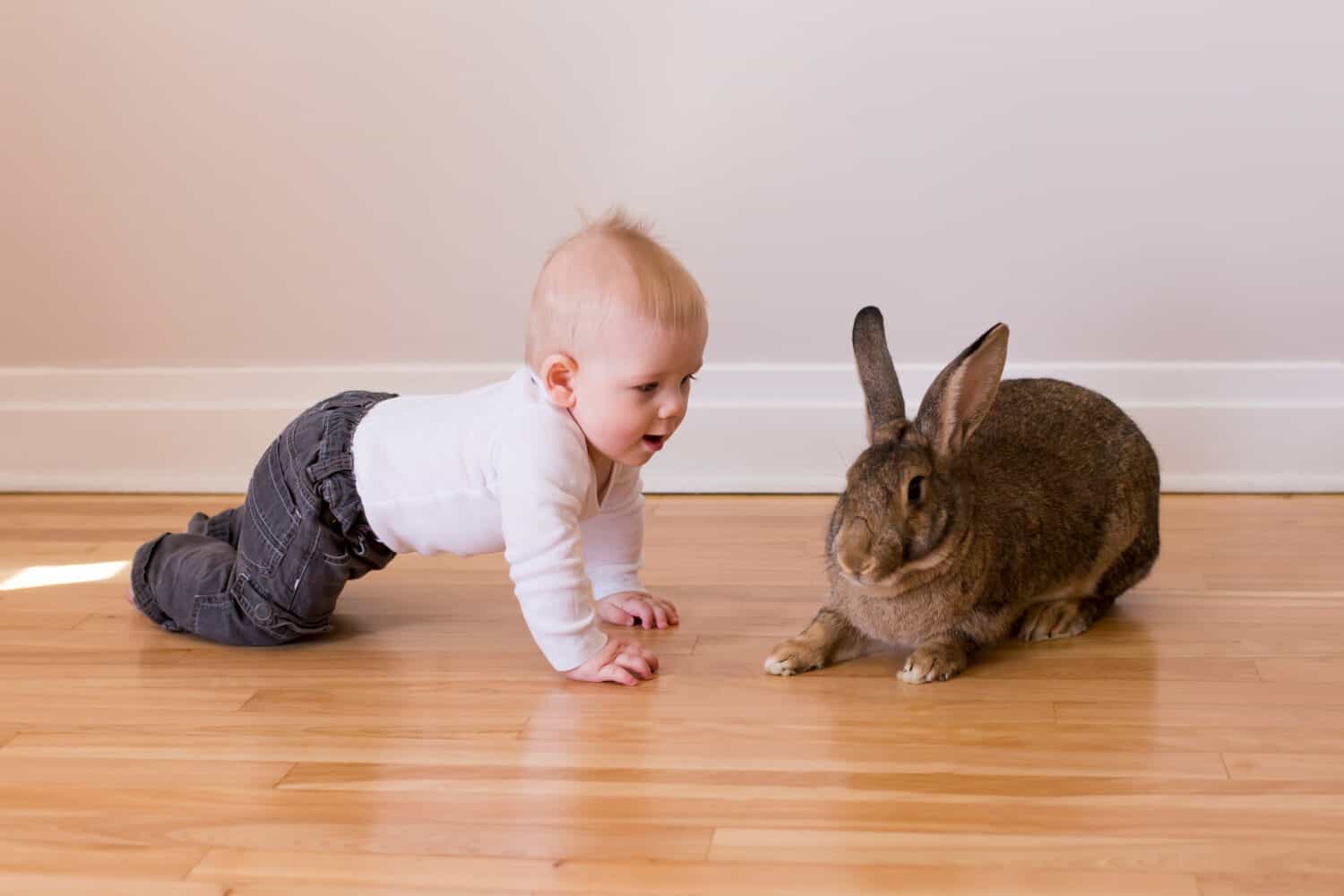
Flemish Giant rabbits can make wonderful companions for any family or individual as long as they have proper care and an environment to thrive in.
©Anne Richard/Shutterstock.com
Do Flemish Giant Rabbits Make Good Pets?
When it comes to rabbit companionship, the Flemish Giant rabbit is a popular and unique choice. Their imposing size and gentle nature create an enchanting array of traits that make them exceptional companions for families and individuals of all backgrounds and experience levels.
A Gentle Demeanor
What sets the Flemish Giant rabbit apart from its counterparts is its remarkable temperament—a symphony of gentleness, curiosity, and affection. Despite their colossal size, these gentle giants are known for their calm and friendly disposition. Their mild-mannered nature makes them well-suited for families, individuals, and even seniors seeking a delightful companion to share their lives with.
Bonding and Social Interaction
Flemish Giants thrive on social interaction, forming strong bonds with their human caregivers. Their innate curiosity and trustful demeanor pave the way for meaningful connections. Spending quality time with them, such as gentle petting, offering treats, engaging in playtime, and simply sharing space with them, helps nurture the unique human-animal relationship.
Size and Presence
One cannot ignore the awe-inspiring presence of the Flemish Giant rabbit. Despite their size, these rabbits are remarkably graceful in their movements. Their large, expressive eyes and fluffy fur coat only add to their captivating charm. Their grand size requires specific attention, though, too. These rabbits thrive best as free-roaming house rabbits or living in a large outdoor enclosure that isn’t exposed to dramatic temperatures. They are incredibly clean by nature and easily litter-trained. They are comparably similar to cats when it comes to house pets.
Interaction with Other Pets
Due to their gentle nature, Flemish Giants can often get along well with other pets, including rabbits, cats, and even dogs. However, proper introductions and supervision are key to ensuring harmonious interactions.
Vocal Expressions
These giants are not excessively vocal, but they do communicate through various means. Soft grunts, purrs, and subtle body language convey their emotions and needs. Being attuned to their cues strengthens the bond between the rabbit and caregiver and provides the rabbit with respect.
Caring for a Flemish Giant Rabbit
The path to ensuring how long a Flemish Giant rabbit can live, in addition to their lifelong well-being, involves a harmonious blend of attentive care and understanding of their unique needs. Let’s look a closer look at how to care for a Flemish Giant rabbit.
A balanced diet is the cornerstone of health. As mentioned earlier, they require approximately 70% of their diet to consist of fiber, such as high-quality timothy hay, in addition to fresh vegetables, specially formulated rabbit pellets, supplemental salt and mineral blocks, and occasional treats such as fruit. All elements aid in meeting their nutritional needs.
Their dense fur requires regular brushing on occasion. Once a week is usually all that is necessary, as rabbits are efficient self-groomers. Grooming sessions also offer an opportunity for bonding.
A spacious and secure living environment is essential. Ensure their living area is free from hazards, with adequate space for movement and exploration. In addition, mental stimulation is crucial for their happiness. Provide toys, tunnels, and opportunities for exploration to prevent boredom.
Finally, building trust and a strong bond takes time. Spend quality time with your Flemish Giant. Handling them gently and respecting their boundaries is crucial for their well-being and the relationship you share.
Flemish Giant Rabbits Make Great Pets
Overall, their gentle demeanor and affectionate nature make them not only exceptional companions but also cherished members of the family. Nurturing the well-being of a Flemish Giant rabbit requires an understanding of their temperament, coupled with dedication to the specific care and environment they need to ensure a long and happy life. If you’re looking to bring a Flemish Giant into your family, the National Federation Of Flemish Giant Rabbit Breeders is a good resource that has an approved breeders list.
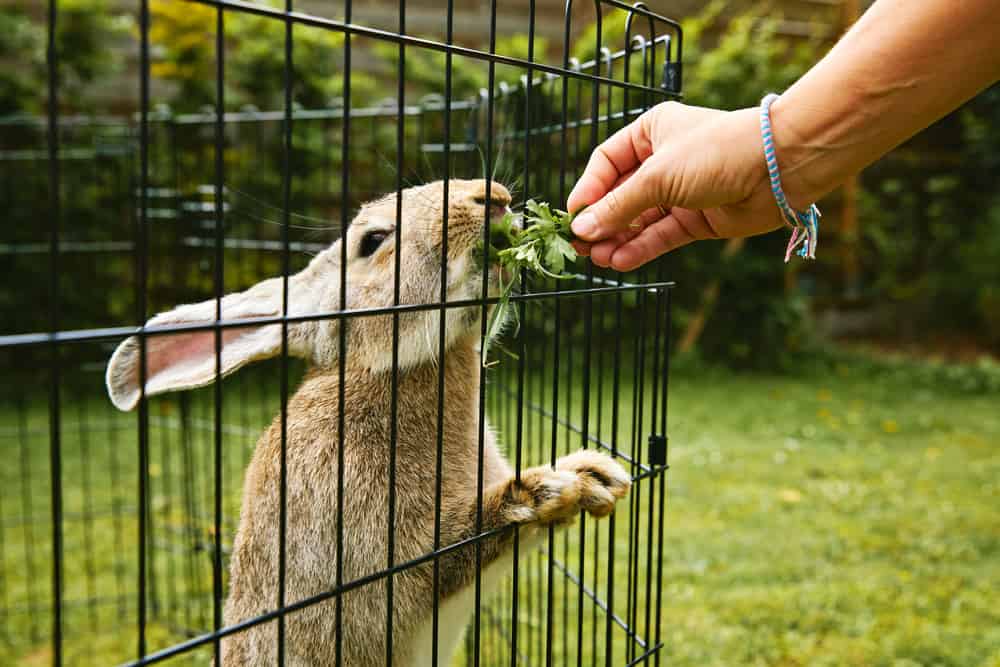
Flemish Giant rabbits live an average of 8 to 10 years long. However, they can surpass the ten-year mark with optimal care and attention throughout their lives.
©mariesacha/Shutterstock.com
Conclusion
The Flemish Giant rabbit is a remarkably gentle creature that has served many purposes throughout its history. Flemish Giant rabbits live as long as 8 to 10 years on average. But they also surpass the ten-year mark regularly when given optimal care and enrichment throughout their lives. These gentle giants stand as a testament to the art of selective breeding and attentive guardianship. By following proper care through the utilization of a nourishing diet, a comfortable environment, regular veterinary care, and affectionate interaction, caretakers create an optimal environment for their Flemish Giant companion to flourish.
The photo featured at the top of this post is © Eric Isselee/Shutterstock.com
Thank you for reading! Have some feedback for us? Contact the AZ Animals editorial team.




